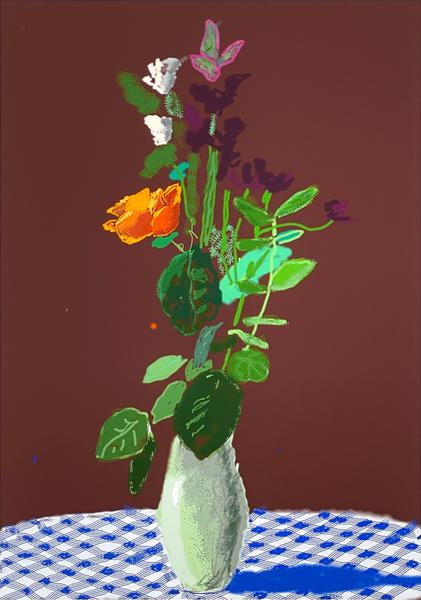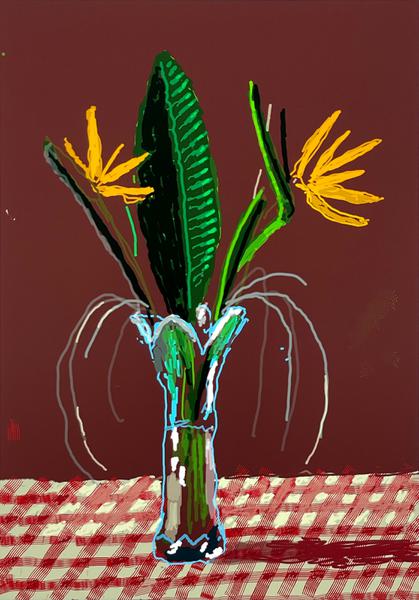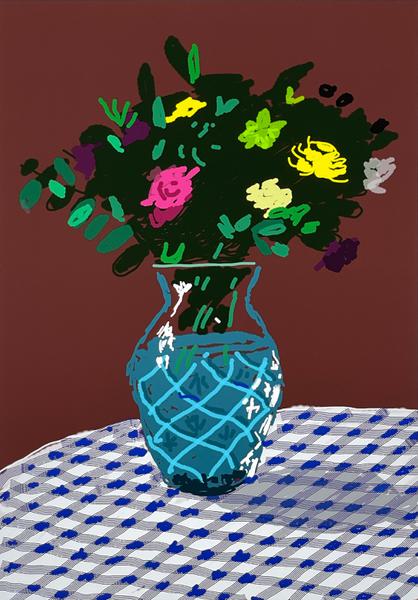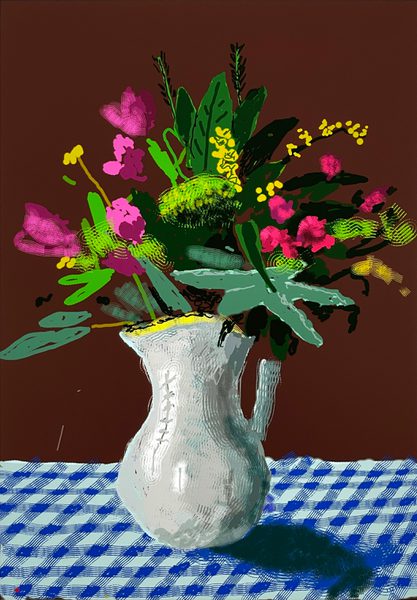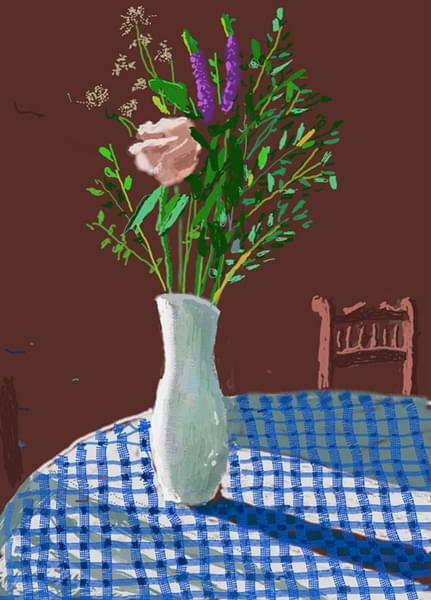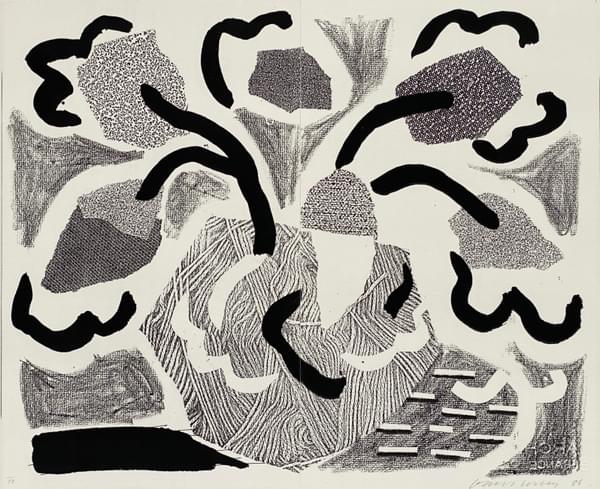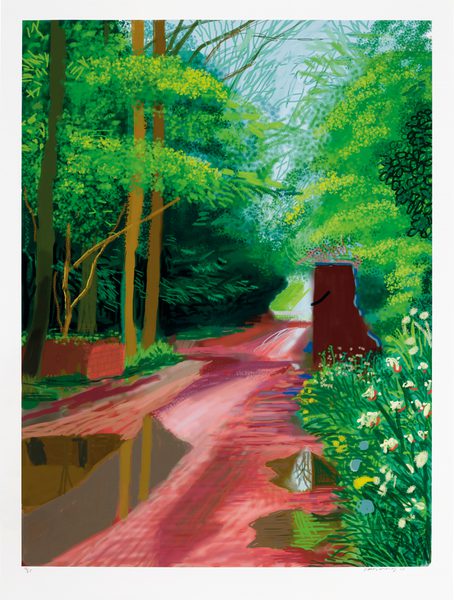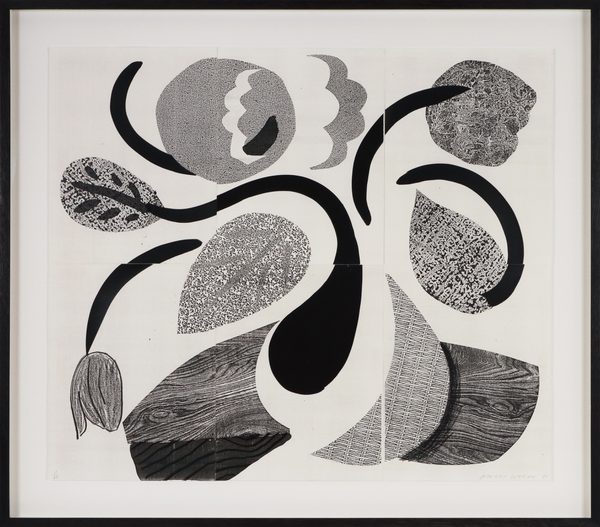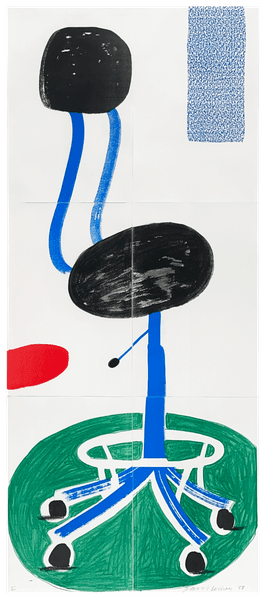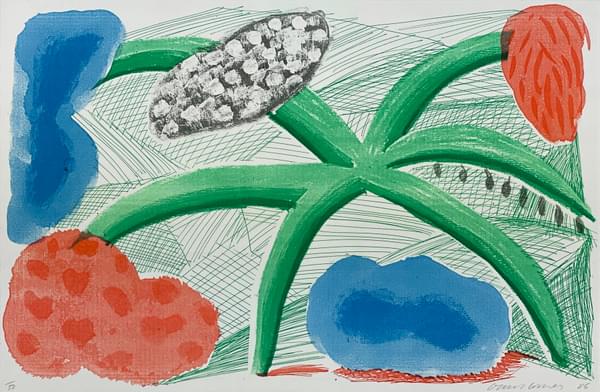Celia Seated on an Office Chair
Celia Birtwell is one of the most iconic textile designers in British fashion history. Born in Greater Manchester, she was educated at Salford Technical college and in 1961 she moved to bohemian London where she met David Hockney who was clearly on the brink of success. She knew Hockney’s then companion Peter Schlesinger well and became a close friend and muse to the artist after they separated in 1971.
Birtwell first sat for Hockney in 1969 and as many as 80 times subsequently, appearing in approximately a quarter of his entire printed portraiture oeuvre. Hockney captured Birtwell through the years, tracing their long and enduring relationship and reflecting the artist’s loyalty to lifelong friends. Hockney expressed a great fondness for his friend when he said ‘Celia has a beautiful face, a very rare face with lots of things in it which appeal to me. It shows aspects of her, like her intuitive knowledge and her kindness, which I think is the greatest virtue. To me she's such a special person…’ Hockney's intention with his portraiture was to capture not only likeness, but something of deeper psychological significance, stating ‘Portraits aren't just made up of drawing, they are made up of other insights as well. Celia is one of the few girls I know really well. I've drawn her so many times and knowing her makes it always slightly different. I don't bother getting the likeness in her face because I know it so well. She has many faces and I think if you looked through all the drawings I've done of her, you'd see that they don't look alike.’ Most importantly for Hockney, ‘It’s [the sitter’s] mood and your mood together that creates whatever’s there’.
With a striking economy of line, the portrait is imbued with a quiet and tender immediacy. Seated in three quarters view with her hands clasped in her lap, her gaze distantly averted, the portrait presents a sombre and contemplative mood. Perched tentatively on the edge of the chair with her weight slightly forward and her legs slanted downwards, Birtwell’s body language is in marked contrast to the leisured sitter she frequently appears as. Her knees are spread apart almost parallel to the ground it is as if she might collapse forward to a kneeling position, surrendering to the weight of hardships she faced at the time. This portrait was completed in 1974, when Birtwell was aged 33. It was also the year after she left her husband Ossie Clark, taking with her their two sons following the collapse of a marriage that had reached a bitter ending. She also left the fashion industry that year to focus on raising her children and began teaching at colleges across London, including Chelsea College of Art.
Each portrait of Birtwell conveys a specific psychological profile punctuating the life of the sitter. Indeed, Birtwell remarked of the portraits that 'just like perfume can transport you to another place, looking at them takes me right back to that moment when we were still so young.' A masterfully rendered etching with aquatint, Hockney creates fine detail and shows the sinuosity of line and cut typical of bohemian fashion of the 1960s and 1970s. Celia’s relaxed blouse crumples over her wide belt and a long string of beads cascades round her neck. A young textile designer at the top of the ‘Swinging Sixties’ fashion industry, Birtwell’s patterned blouse may indeed be one of her own designs. In 1965 she collaborated with Ossie Clark and Alice Pollock to create a collection of bold, nature inspired fabrics for the Quorum boutique in Kensington. By varying the intensity of the etched lines, Hockney produced shading to create texture, hues and a sense of three-dimensionality. The large open window pours light into the sitter's lap and casts a shadow revealing the contortions of her thigh and bent knee. Her hair is untidily arranged in wiry curls on top of her head adding to the impression of Birtwell's effortless style.
The portrait is a demonstrative of the artists ingenious use of colour. Despite its pared-down palette, Hockney creates an image that is varied and optically intriguing in its brilliance. We can discern something of the artist’s systematic method, building the image with individually applied colours. The blue of the office chair seeps through the body, faintly outlining it and is included in the cool tones of her skin as well as in the detail of her blouse. An ochre red is used in varying strengths where deep red ringlets neatly frame her face and in other areas pinkish-red hues bring a warmth and vitality to her complexion. A rich black is used to add definition to her facial features and is used to colour her long skirt, beneath which we glimpse a red underskirt.
Birtwell was one of the five subjects who appeared in works exhibited as part of ‘Drawing from Life’ at the National Portrait Gallery in 2020. She also famously appears in a double portrait with her then husband Ossie Clark titled ‘Mr and Mrs Clark and Percy’, 1971 which is one of the most viewed pieces at the Tate Gallery. In 2005 it was shortlisted for the “The Greatest British Painting” on the BBC’s Today Programme. Spanning a quarter of a century, Hockney created an intimate visual record between the two close companions honouring both the process of change, as well as deep continuity and consistency that define one's identity and relationships through the passage of time. Indeed, this work can and should be compared to other portraits of his friend and muse where both subtle and notable changes in the vestiges of her physiology are depicted. Moreover, by looking at these portraits we are able to track the evolution of Hockney's style and appreciate his vigorously experimental work ethic, constantly mastering new mediums and techniques.
A portrait of Birtwell completed over the course of 5 days in 2015 was included in the Royal Academy exhibition “David Hockney RA: 82 Portraits and 1 Still-life”. He captures her with a similarly distant stare, albeit rendered in fauve-bright coloured acrylic paint. Hockney owes much to his forefathers whose methods sparked his curiosity. He was greatly inspired by the domestic scenes executed by Matisse, particularly his elegant and subdued portraiture. When considered in their entirety, the works offer a gentle meditation on time passing. In 2011 Celia was awarded a CBE in the Queen's Birthday Honours List for her outstanding contribution to fashion and in September of the same year a book was published about Celia’s life in design.
Another impression of this print can be found in the permanent collection of the Fukuoka Art Museum, Japan as well as in The David Hockney Foundation.
Celia Seated on an Office Chair
- Artist
- David Hockney (b.1937)
- Title
- Celia Seated on an Office Chair
- Medium
- Etching, soft ground etching and aquatint in colours, on Rives BFK paper
- Date
- 1974 / 1981
- Size
- 35½ x 29½ in : 90.2 x 74.9 cm
- Framed Size
- 40 x 33 ¾ in : 101.5 x 86.0 cm
- Edition / Inscriptions
- From the edition of 60, signed, dated and numbered in pencil
- Printer
- Printed by Maurice Payne
- Publisher
- Published by Petersburg Press in 1981
- Literature
- Museum of Contemporary Art, Tokyo, and Tankosha Publishing Co., Ltd., Pub., David Hockney Prints 1954-1995, 1996, cat. no. 160, p.106 (col .illus.)
- Reference
- A21-83
- Download PDF
- Status
- Available
Available Artists
- Albers Anni
- Ancart Harold
- Andre Carl
- Avery Milton
- Baldessari John
- Barnes Ernie
- Calder Alexander
- Castellani Enrico
- Clough Prunella
- Crawford Brett
- Dadamaino
- de Tollenaere Saskia
- Dyson Julian
- Elsner Slawomir
- Freud Lucian
- Gadsby Eric
- Gander Ryan
- Guston Philip
- Haring Keith
- Hartung Hans
- Hayes David
- Held Al
- Hepworth Barbara
- Hill Anthony
- Hitchens Ivon
- Hockney David
- Hutchinson Norman Douglas
- Jenney Neil
- Katz Alex
- Kentridge William
- Knifer Julije
- Kusama Yayoi
- Le Parc Julio
- Leciejewski Edgar
- Léger Fernand
- Levine Chris
- Marchéllo
- Martin Kenneth
- Mavignier Almir da Silva
- Miller Harland
- Mitchell Joan
- Modé João
- Moore Henry
- Morellet François
- Nadelman Elie
- Nara Yoshitomo
- Nesbitt Lowell Blair
- Nicholson Ben
- O'Donoghue Hughie
- Pasmore Victor
- Perry Grayson
- Picasso Pablo
- Pickstone Sarah
- Prehistoric Objects
- Riley Bridget
- Ruscha Ed
- Sedgley Peter
- Serra Richard
- Shrigley David
- Smith Anj
- Smith Richard
- Soto Jesús Rafael
- Soulages Pierre
- Spencer Stanley
- Taller Popular de Serigrafía
- The Connor Brothers
- Vasarely Victor
- Vaughan Keith
- Whiteread Rachel
- Wood Jonas
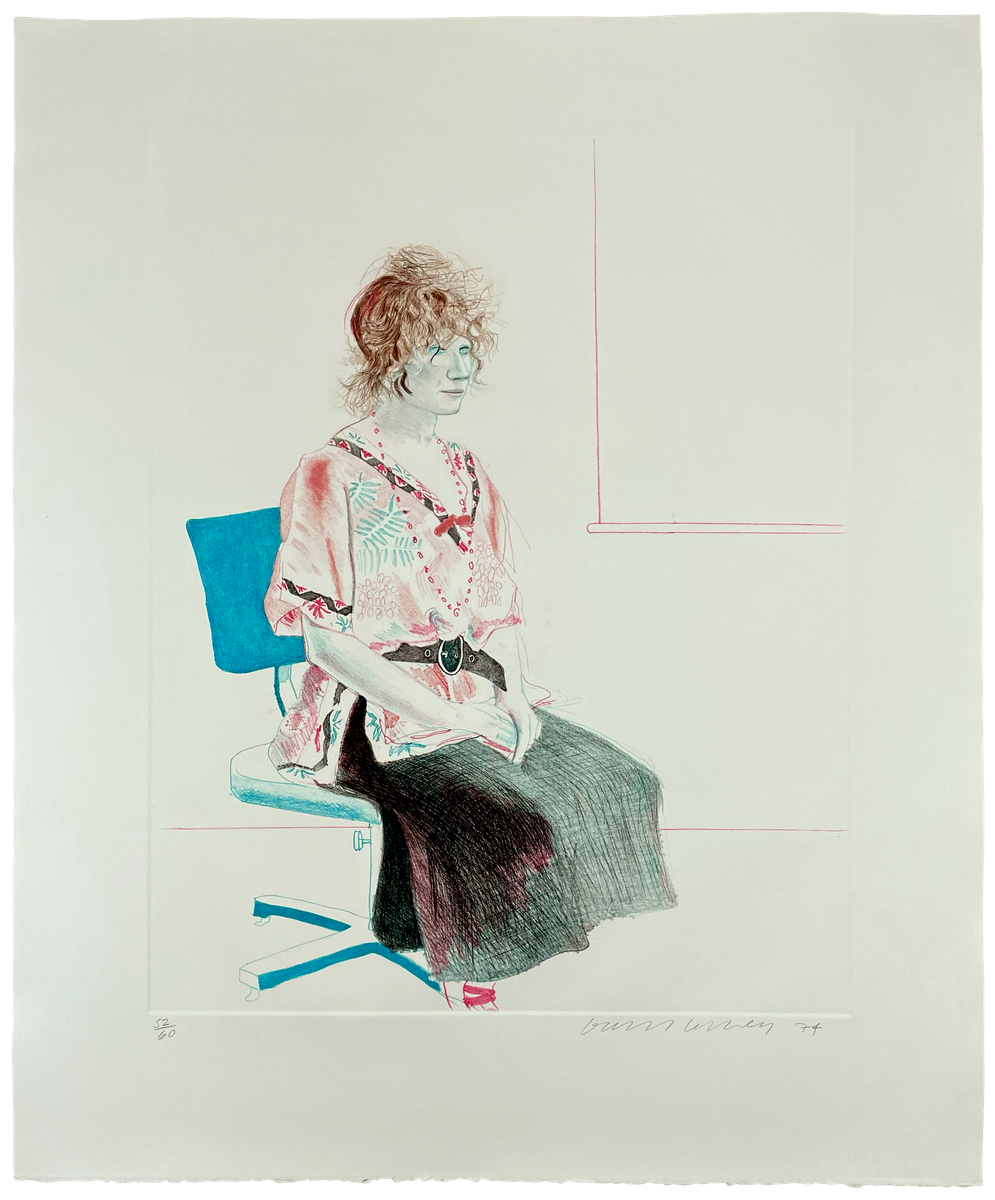
![Untitled [Water] - David Hockney](https://images.archeus.com/production/AC25-02-HOCKNEY-Water-Study-frame-crop.jpg?w=600&h=600&q=60&auto=format&fit=clip&dm=1759324888&s=3221efcb271df836a8c1f8fcc855c56c)


